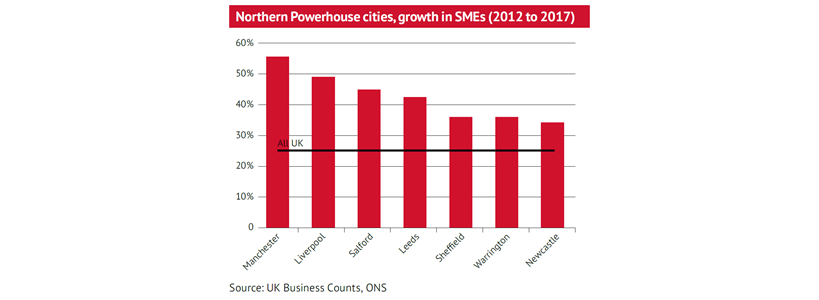The impact of technology
Technology, more specifically the internet, is changing the way businesses operate. The advantage of being bigger in order to be more efficient and profitable is rapidly being eroded.
Instead, technological advancements such as Cloud Computing have reduced overheads and lowered barriers to entry, spurring entrepreneurialism and leading an explosion of start-up’s. Automated business processes have also enabled larger organisations to become more streamlined, improving productivity while simultaneously reducing headcount
With the number of businesses employing less than 50 individuals having risen by 25% since 2012, SMEs have become an integral part of the UK economy. This is a trend which shows no signs of slowing, as new technologies such as Artificial Intelligence, Big Data and the Internet of Things become increasingly commonplace in the modern business environment.
The Northern Powerhouse effect
The North of England – where office market activity has historically been underpinned by back office moves from blue chip organisations owing to its comparatively lower operational costs – has one of the highest concentrations of SMEs of any UK region; over 1m in fact, with a combined annual revenue of £214.9bn in 2016.
Fuelled by a clear commitment from the Government to supporting the organic growth of local businesses, including strong financial support in the form of the Northern Powerhouse Investment Fund, cities such as Manchester, Liverpool and Salford have become thriving hot-beds of SME-activity.
With consistently above average take-up for smaller units, this trend has been clearly reflected in the occupier markets over the past few years. Furthermore, over the 12 months to Q3 2017, the eight key markets of the Northern powerhouse have seen well over 1,000 deals of below 5,000 sq ft, making up 82% of transactions.

Evolving workspace requirements
Historically, the majority of new supply that has come through the development pipeline has been aimed at larger corporates, ideally sole occupancy with large floorplates.
The challenge for landlords is to react to the evolving workspace requirements brought about by this change in business structure in order to capitalise on the growing level of demand.
To a certain extent, this has already begun. Long lease structures traditionally favoured by institutions are becoming less common, with the average lease length now between three and five years. The historic cynicism surrounding covenant strength is also lessening.
Fuelled by the rise in popularity of CoWorking spaces from the likes of Work:Life and WeWork, the somewhat dated business model of the serviced office market is also undergoing a massive shake-up.
Space to grow
While serviced office and CoWorking space typically caters for between one and 10 employees, what of the 43,465 businesses across the North of England that employ between 10 and 50 members of staff?
Some forward-thinking landlords have begun to realise that they can maximise the use of second-hand space by targeting this growing cross-section of businesses.
This new concept of flexible workspace is typically provided in shell specification together with capped services and all inclusive rent and service charge deals, enabling tenants to occupy the space with maximum ease and minimal risk.
Bruntwood’s Platform in Leeds is one such example. With a variety of evolved workspaces that can accommodate a mix of small, creative businesses, start-ups and SMEs, along with bigger, larger corporates, the 120,000 sq ft, 13-storey grade A office building provides the flexibility to grow within the building throughout the lifecycle of the business.
Elsewhere across the North, landlords are also responding to difficulties in attracting larger occupiers by repositioning existing buildings. Q11 Quorum Business Park in Newcastle was recently sub-divided into smaller suites and is now almost fully let, with Q10 due to be carved up to accommodate smaller grade A requirements following its success.
Urban Splash’s iconic Grade II Listed Park Hill scheme in Sheffield has also seen unprecedented levels of demand, with just 4,425 sq ft remaining from of a total of 30,000 sq ft.
As such, enquiries are now being taken for Phase 2, which includes proposals for circa 27,000 sq ft of commercial space.
Supporting a thriving economy
While businesses of a certain size will always require larger floorplates, SMEs are a critical component of the future success and vibrancy of the Northern Powerhouse economy and are likely to have a transformative effect on the UK’s commercial property market in the years ahead.
Landlords therefore have a vital role to play in nurturing our thriving SME sector by providing high-quality, flexible office space which is capable of responding to the ever-changing needs of modern businesses.
REGISTER FOR UPDATES
Get the latest insight, event invites and commercial properties by email







